|
 BY JNFERRIGNO
BY JNFERRIGNO
Growing up, I had a beautiful blue
eyed Dalmatian
named Katie. She was
the kindest, sweetest girl ever, and no one ever questioned her blue
eyes, they just stated how beautiful they were. Years later I move in
with a friend who owns a Beagle named Lady. Lady has one blue eye, and
suddenly no matter where we are, there is always someone questioning
what is wrong with her eye. When asked what they think is wrong with
it, they ask if she is blind. This took me by surprise, considering no
one ever questioned Katie’s eyes. I wondered how these myths
came
about, and thought to myself if this many people believe this to be
true, how many others feel the same?
Myths
1. Dogs with blue eyes are or blind or deaf.
2. Blue eyed dogs are light sensitive.
3. Blue eyes pits are more aggressive then other dogs.
Oddie
is a Double Merle Australian Shepard. Aside from being deaf, this boy
is also going blind due to the unique nature of the Merle Gene. He was
born with a irregularly shaped pupil, known as a Star Burst pupil,
which prevents his eyes from properly dilating in the sun. Because most
of his body lacks the pigment it needs to protect his skin from the
sun, it makes him all the more susceptible to sunburns or possible skin
cancer. To learn more, visit lethalwhites.com.
Deaf
and Blindness
The
majority of blue eyed dogs are not deaf. Most dogs who have blue eyes
and are deaf result from a double copy of the merle gene. Merle, in a
homozygous state, can be lethal, and can produce all white, or nearly
all white, animals with blue eyes and deafness. However, deafness and
blue eyes are not genetically linked together. It is actually linked to
the lack of pigment in the inner ears, which often includes a lack of
pigment in the eyes. Due to the unique nature of skin pigmentation,
dogs can be deaf/blind on one side or both sides when there is a large
amount of white present. Aside from merle, this pattern can also be
seen in dogs with excess white, like Dalmatians. Katie’s blue
eyes were
the result of a recessive gene, however her two deaf daughters had
brown eyes.
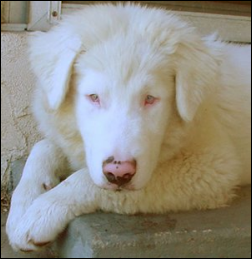
Blue
eyed dogs, are no more sensitive to light then blue eyed humans.
However, if said blue eyed dog is an albino, they will have changes in
their eyes and optic nerves. In canines, albinos are different then
white dogs, who still maintain their eye color. Albino Dobermans are
known to have these problems, along with other neurological problems.
Blue
Pit Bulls
Blue
pits, like fawn pits, are colors that result from dilution genes on
black and red base coats. In blue pits their eyes actually are a smokey
color and not a true blue. In fact, responsible breeders avoid blue
eyes in the breed because it’s consider a fault. Some dogs
may
fear
bite because of hindered eyesight, like cataracts, however there is no
genetic evidence to suggest a relation between aggression and eye
color.
There are always acceptations to the
rules. Just
because your dog has a lot of white and blue eyes, does not mean it is
deaf. There are some dogs out there that miss the bullet and avoid
being blind or deaf. The sure fire way of knowing for sure is taking
them into your Vets office where they will provide a sound and sight
check.
 |
 BY
KHOLRAN
BY
KHOLRAN
“What’s a degu?”
That’s probably the most
frequently asked
question I get when I tell someone that I own a pair of them. So what
are they? Degus (Octodon degus) are medium sized rodents from South
America (Chile to be exact). In captivity, they can be expected to live
between five and seven years, and their average size is about 6 inches
in length. Their closest relatives are chinchillas and guinea pigs.
“So what do I need to know
about degus as
pets?”
Degus
can make fun small companions. They are highly social and so are
generally very friendly towards people if socialized correctly. Like
many rodents, rats and chinchillas included, degus should never be kept
alone. In the wild, they live in massive colonies, and as pets, it is
always best to give them a companion of their own species (of the same
gender!) to play with and ‘talk‘ to. They are also
highly
intelligent,
on par with rats, and very vocal with a wide array of whistles, clicks,
and grunts. Unlike many other species of rodents, degus are active most
during the day. While most socialized degus enjoy handling and
attention from their humans, owners do need to use caution when taking
them out of their cages. They can get themselves into trouble and can
be very difficult to catch if left to roam around a room, even with
supervision. Electrical cords look very similar to the roots that their
wild relatives would eat, and almost everything is fair game as a chew
toy.
A degu’s diet is very
important, and must be
carefully
planned. They are unable to process sugar, and so are prone to diabetes
if their diets contain too much sugar. Degus need diets high in fiber
and low in sugar and fat. Hay (either Timothy or Orchard Grass) should
make up the predominant part of a degu’s diet. There are
currently no
commercial diets formulated for degus available in US pet stores,
however chinchilla or guinea pig pellets can be a suitable alternative.
Be careful, though! Many pellets are very high in sugar (in the form of
molasses or dried cane). Never feed mixes containing small colored
pieces (not even to the animals they’re marketed to!) or seed
mixes;
feed only plain timothy-based pellets.
Degus are on the larger
side as far as rodents go, and so need a large cage. They are very
active, and need plenty of space to run and climb. Aquariums are
not recommended, as they are not properly ventilated. Toxic
levels
of
ammonia can build up in glass-sided cages, |
leading
to health problems
and death. Similarly, degus should not be housed in plastic or wood
cages, as they are notorious for their chewing and will “let
themselves
out” while the owner isn’t looking. Wire-sided
cages with
multiple
levels are best suited to the degu’s housing needs, but
beware of
housing with wire floors. Like rabbits and other rodent species,
painful foot sores can develop if they do not have solid flooring to
stand on. The floor of the cage should be lined with a deep layer of
soft bedding, but be careful to avoid wood shavings, which can irritate
eyes and lungs. A paper or fiber-based bedding, such as Carefresh or
Soft Comfort, is the most ideal.
When it comes to “cage
accessories”, there are a few very important things that your
degu cage
will need before it can truly be called home. Because of their
intelligence level, it’s very important to keep pet degus
stimulated.
Cage toys can be as simple as a cardboard tube stuffed with hay, or a
few apple branches hung from the top of the cage. Degu teeth continue
to grow throughout the animal’s life, and so it is very
important
to
have enough hard materials for them to chew on. Small houses made out
of pine, willow, or apple wood can provide both chewing areas and hidey
holes. Naturally, clean, fresh water is important to all living things,
and while some small animals prefer a dish of water, degus are
perfectly content to drink out of water bottles- but be careful to
attach them on the outside of the cage only, to avoid chewed-through
bottles and flooded cages. Lastly, like chinchillas, degus need regular
dust baths to keep their skin and coats healthy. Be sure to keep the
dust in a high-sided container to avoid getting it everywhere (and it
really does get EVERYWHERE!).
Degus are unique but very social
and intelligent rodents that can adapt to most any living area. Like
most small pets with teeth, they are not ideal for children, and should
never be left free to roam on their own without strict rodent-proofing
and a secure environment. For those owners willing to put in the time
and effort, degus make great pets with a longer lifespan than many
other captive rodent species.
|
I had originally intended this for
curly horse
hair, however these
techniques would be universal for  canine hair as well, like the Curly
Coated Retriever, or even Poodle. While just summarized in this
article, for the entire piece please visit my DeviantArt Gallery. canine hair as well, like the Curly
Coated Retriever, or even Poodle. While just summarized in this
article, for the entire piece please visit my DeviantArt Gallery.
The
most important trick is how to create the texture of curly fur. Other
furs seen in wolves and huskies tend to be easier and more free
flowing. In this instance, brush size, opacity, pressure sensitivity
(if using a tablet) are all important, but the most important factor is
the strokes which your hand make.
l animals will require
such detail, so for those  animals the first step is all you need
(just
build up your colors as mentioned below). If you do choose to blend, I
like to use any number of assorted brushes my computer program
provides. You should not over blend, a once-over is sufficient enough
just to give it a little direction. animals the first step is all you need
(just
build up your colors as mentioned below). If you do choose to blend, I
like to use any number of assorted brushes my computer program
provides. You should not over blend, a once-over is sufficient enough
just to give it a little direction.
The color palette you
choose is also important. I like to work with no less then four colors,
two medium shades, one darker, and one lighter. If you have a tablet,
some where in your drawing program you should have tool options, and
see an option there for varying color. I like to use this option
because it will naturally mix any two of the colors from my palette
that I choose. The way I build up my color, is I work with a medium
base, and go darker, then lighter, making sure that with every new
color I create a new layer.
 Final Product
Final Product |
|




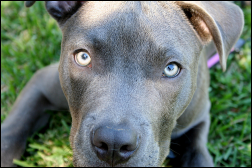



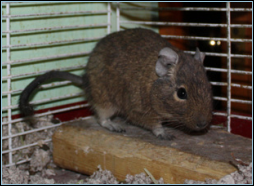
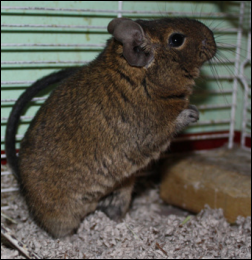

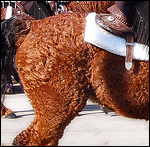
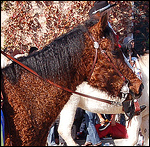

 canine hair as well, like the Curly
Coated Retriever, or even Poodle. While just summarized in this
article, for the entire piece please visit my
canine hair as well, like the Curly
Coated Retriever, or even Poodle. While just summarized in this
article, for the entire piece please visit my  animals the first step is all you need
(just
build up your colors as mentioned below). If you do choose to blend, I
like to use any number of assorted brushes my computer program
provides. You should not over blend, a once-over is sufficient enough
just to give it a little direction.
animals the first step is all you need
(just
build up your colors as mentioned below). If you do choose to blend, I
like to use any number of assorted brushes my computer program
provides. You should not over blend, a once-over is sufficient enough
just to give it a little direction. 
